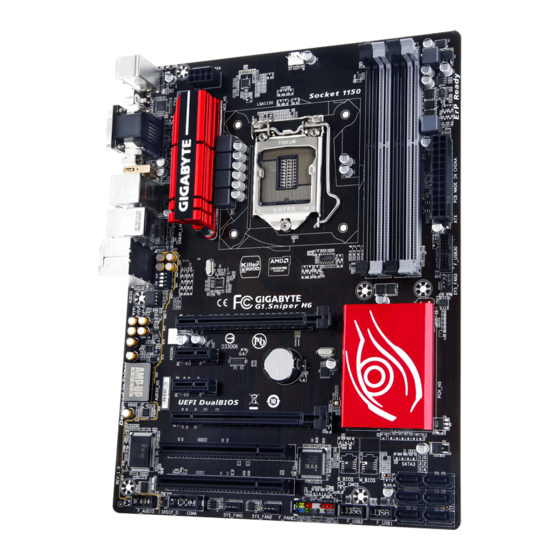
Summarization of Contents
Declaration of Conformity
Manufacturer/Importer Information
Details about G.B.T. Technology Trading GMbH and its address and conformity statements.
FCC Declaration
FCC compliance statement from G.B.T. INC. (U.S.A.) regarding Class B digital device.
Copyright and Disclaimer
Documentation Classifications
Describes the types of documentation provided by GIGABYTE for product use.
Identifying Your Motherboard Revision
Explains how to identify the motherboard revision number for updates and technical information.
Product Specifications Overview
Expansion Slot Details
Information on PCI Express and PCI slots, including configurations and bandwidth.
Motherboard Connectivity and Interfaces
Back Panel Connector Descriptions
Explains the purpose and connectivity of each port on the motherboard's back panel.
Internal Connector Overview
System and Peripheral Connectors
Details power, fan, SATA, front panel, audio, USB, and COM headers for system and peripheral connections.
CMOS and Battery Management
Instructions for clearing CMOS settings and replacing the motherboard battery.
Classic BIOS Setup Interface
Classic Setup Function Keys
Lists and explains the function keys used for navigating and operating within the Classic BIOS Setup.
M.I.T. (Memory Intelligent Tweaker) Overview
Advanced Frequency Settings
Details settings for overclocking and adjusting CPU, PCIe, and memory frequencies.
Advanced CPU Core Settings
Configuration options for CPU clock ratios, frequencies, and core-related settings.
CPU Power and Thermal Management
Explains settings for CPU power saving features like Turbo Boost, C-states, and thermal monitoring.
Advanced Memory Settings
Configuration options for memory performance, including X.M.P. profiles and memory multipliers.
Memory Timing and Performance Tuning
Options for fine-tuning memory timings, enhancement settings, and channel configurations for optimal performance.
Voltage Settings and System Health Monitoring
Configuration for CPU, chipset, and memory voltages, plus monitoring system health indicators.
PC Health Status Details
Detailed display and control of system voltages, temperatures, fan speeds, and warning thresholds.
Fan Speed Control Configuration
Options for manually controlling fan speeds and setting fan speed percentages for system cooling.
Miscellaneous Performance Settings
Settings for PCIe slot configuration, DMI link speed, and legacy benchmark enhancement.
BIOS Feature Configuration
System Boot and Device Support Features
Configuration for security, boot speed, VGA, USB, PS/2, network, and CPUID settings.
Advanced System and OS Features
Settings for security features, virtualization, OS compatibility, CSM support, and boot device control.
Peripheral Device Configuration
Onboard Device Configuration
Controls for onboard audio, LAN, graphics, USB ports, and PCIe slot bandwidth.
SATA Controller and Mode Configuration
Settings for enabling SATA controllers, selecting modes (IDE, RAID, AHCI), and configuring hot-plug.
System Power Management Settings
Advanced Power Saving and Wake-Up Features
Configuration for AC power recovery, wake-up, and ASPM power management.
Configuring SATA Hard Drive(s)
RAID Levels Overview
Table summarizing RAID levels, minimum drives, capacity, and fault tolerance.
UEFI RAID Configuration
UEFI RAID Configuration Steps
Instructions for setting up UEFI RAID, including BIOS Feature adjustments and accessing Intel RST utility.
Creating UEFI RAID Volumes
Guide on creating RAID volumes, selecting disks, setting strip size, and capacity in the RAID utility.
Confirming RAID Volume Creation
Final steps to create the RAID volume and view its details within the Intel RST interface.
Legacy RAID ROM Configuration
Creating Legacy RAID Arrays
Detailed process for creating legacy RAID arrays, including volume naming and disk selection.
Recovery Volume Operations
Managing Recovery Volume Data
Instructions for selecting master/recovery disks and setting data synchronization options for recovery volumes.
Rebuilding RAID Arrays
Performing RAID Rebuild in Operating System
Steps to perform RAID rebuilds within the operating system using the Intel Rapid Storage Technology utility.
















Need help?
Do you have a question about the G1.Sniper Z6 and is the answer not in the manual?
Questions and answers